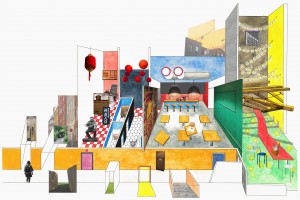The Re:POST Symposium is scheduled for Tuesday, March 17, 2015 beginning at 1:00 pm and asks, how does academic design and research disseminate into ongoing professional exploration? Over the course of the afternoon, three panels will explore, through presentations and discussions, opportunities regarding post-thesis development beyond the date of defence. The presenters and respondents come from diverse backgrounds and have transitioned from thesis research into various forms of practice. This week, we’ll be introducing the practitioners contributing to this year’s Re:POST Symposium.
Reminder: Graduates students, have the opportunity to sign up and discuss your work to this panel during the workshop portion of the symposium.
Panel 2 pairs Matthew Kennedy and Mark Erickson, the duo behind Studio North, with Elizabeth Paden, currently at KPMB Architects, who received significant recognition for her thesis work, including the Canada Council for the Arts Prix de Rome.
Presenter: Studio North – Matthew Kennedy and Mark Erickson
Thesis: While studying architecture at Dalhousie University, Matthew was awarded the Rossetti Travel Fellowship to travel to Japan and research compact housing typologies. Matthew’s architectural thesis focused on developing a strategy for laneway housing in Calgary’s inner city communities. His Master of Architecture thesis was awarded the Thesis Prize for an outstanding design thesis.
Mark completed a Bachelor of Fine Arts at the University of Calgary. He proceeded to achieve a Bachelor of Environmental design and Master of Architecture at Dalhousie University. His international work, including teaching architectural technology at the University of The Gambia in West Africa, has helped broaden his understanding of how architecture is shaped according to culture, climate and geography.
Practice: Studio North is a design and build practice established by Matthew and Mark. Based in Calgary, Studio North connects design with building and craft, where a relationship is maintained between the architectural idea and the act of making. By acting as both the designers and the builders, they are able to creatively and meaningfully engage with the client, the site, and the community in producing better living environments that emphasize the beauty of the landscape. Matthew and Mark have collaborated on architectural projects at a variety of scales, from furniture and art installations to laneway housing. They believe that small scale and well-crafted built interventions are able to stimulate big changes in thought and ways of being.
Respondent: Elizabeth Paden
Thesis: Originally from Sudbury, Elizabeth holds a Bachelor of Science in Architecture and a Master of Architecture from McGill University, where she received the RAIC Student Medal for design, the AIA Henry Adams Medal, and the A.F. Dunlop Traveling Scholarship, which funded research travel to Nunavut in August 2010. Her thesis research explored contested Canadian Aboriginal territories in collaboration with the Mohawk First Nations community of Kahnawá:ke. Her work proposed a built intermediary to negotiate land claim disputes, leverage border infrastructure, reconcile transnational space and open sociospatial margins.
Practice: Elizabeth was awarded the Canada Council for the Arts Prix de Rome in Architecture for Emerging Practitioners in 2010 and spent the following year studying the impact that large-scale public buildings can have on territorial boundaries within geopolitical regions. She worked as a Program Coordinator and Publication Editor at 0047, a multidisciplinary think tank and gallery for architectural research, production and exhibition in Oslo, Norway. Her recent work has been exhibited at Nottingham Contemporary, Norsk Form, and Centre d’Art Neuchâtel.
In the five years since joining KPMB Architects in Toronto, Elizabeth has worked on a number of notable projects including the Princeton University School of Economics, the George Brown College Waterfront Health Sciences Campus, and the University of Waterloo Quantum Nano Centre. Most recently, she was named Project Architect for the Assiniboine Park Conservatory, a multi-functional landform biodome in Winnipeg.



Leave a Reply